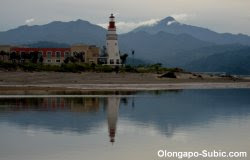Subic, Clark freeports seen helping Central Luzon to grow at least 6.9%
Buoyed by the presence of Subic Bay and Clark freeports, Central Luzon is likely to post a 6.9 percent economic growth this year despite the crisis, the country’s economic managers said.
With the presence of Subic Bay and Clark freeports in Central Luzon, a 6.9 percent economic growth is “highly attainable” in the region this year despite the global economic slowdown, Philippine economic managers said.
The economic forecast was made during a recent briefing here at the Subic International Hotel, where the country’s top economic officials held back-to-back presentations on the government’s strategies to override the effects of the financial crisis.
The team of speakers was headed by Department of Finance (DoF) Secretary Margarito Teves, National Economic and Development Authority (NEDA) Secretary Ralph Recto, and Bangko Sentral ng Pilipinas (BSP) Director Iluminada Sicat.
Also present were Department of Agriculture (DA) Undersecretary Segfredo Serrano, Department of Budget and Management (DBM) Undersecretary Laura Pascua, Department of Energy (DoE) Undersecretary Roy Kyamko, Department of Trade and Industry (DTI) Region 3 Director Blesila Lantayona, and NEDA Region 3 Director Remigio Mercado.
During the briefing, Teves said the government’s fiscal reform has generated revenues that are now being invested into two economic sectors public infrastructure and social services to pump-prime the national economy. He specifically cited the Subic-Clark growth corridor as “steps ahead” compared to neighboring areas because of major infrastructure projects already in place in the area.
These include the modern seaport in Subic that has given rise to a 600,000-TEU (twenty-foot equivalent unit) container terminal, the Diosdado Macapagal International Airport (DMIA) in Clark, and the Subic-Clark-Tarlac Expressway (SCTEx) that now links the two free ports.
With this advantage, Central Luzon, which made the third largest contribution to the country’s gross regional domestic product (GRDP) at 8.3 percent in 2007, “can focus on other economic arenas like attracting investments, and streamlining the process of doing business in the region,” Teves said.
NEDA’s Mercado said meanwhile that the agriculture and services sectors will stay resilient and provide avenues for regional economic growth amid the global economic slowdown.
He added that the industrial sector’s output in Region 3, however, is expected to go down further since manufacturing, which employs 20 percent of the people in the industrial sector, had been the hardest hit by the financial crisis.
--By BERNIE CAHILES-MAGKILAT
With the presence of Subic Bay and Clark freeports in Central Luzon, a 6.9 percent economic growth is “highly attainable” in the region this year despite the global economic slowdown, Philippine economic managers said.
The economic forecast was made during a recent briefing here at the Subic International Hotel, where the country’s top economic officials held back-to-back presentations on the government’s strategies to override the effects of the financial crisis.
The team of speakers was headed by Department of Finance (DoF) Secretary Margarito Teves, National Economic and Development Authority (NEDA) Secretary Ralph Recto, and Bangko Sentral ng Pilipinas (BSP) Director Iluminada Sicat.
Also present were Department of Agriculture (DA) Undersecretary Segfredo Serrano, Department of Budget and Management (DBM) Undersecretary Laura Pascua, Department of Energy (DoE) Undersecretary Roy Kyamko, Department of Trade and Industry (DTI) Region 3 Director Blesila Lantayona, and NEDA Region 3 Director Remigio Mercado.
During the briefing, Teves said the government’s fiscal reform has generated revenues that are now being invested into two economic sectors public infrastructure and social services to pump-prime the national economy. He specifically cited the Subic-Clark growth corridor as “steps ahead” compared to neighboring areas because of major infrastructure projects already in place in the area.
These include the modern seaport in Subic that has given rise to a 600,000-TEU (twenty-foot equivalent unit) container terminal, the Diosdado Macapagal International Airport (DMIA) in Clark, and the Subic-Clark-Tarlac Expressway (SCTEx) that now links the two free ports.
With this advantage, Central Luzon, which made the third largest contribution to the country’s gross regional domestic product (GRDP) at 8.3 percent in 2007, “can focus on other economic arenas like attracting investments, and streamlining the process of doing business in the region,” Teves said.
NEDA’s Mercado said meanwhile that the agriculture and services sectors will stay resilient and provide avenues for regional economic growth amid the global economic slowdown.
He added that the industrial sector’s output in Region 3, however, is expected to go down further since manufacturing, which employs 20 percent of the people in the industrial sector, had been the hardest hit by the financial crisis.
--By BERNIE CAHILES-MAGKILAT







0 Comments:
Post a Comment
<< Home